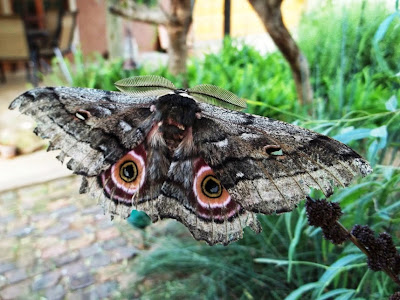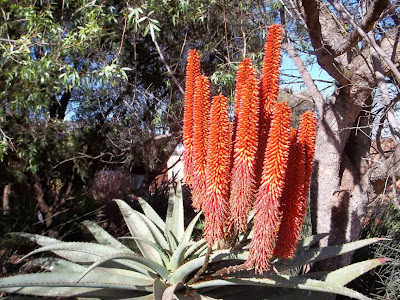You might think that I — a lifelong nature lover — would automatically have been an environmentalist. But it wasn't until late in my 30's, when I seriously started gardening and saw what chemical insecticides, pesticides, herbicides and poisons (like rat poison) were doing to the insects and wildlife, that I became one through and through.
How we choose to manage pests in our yards is important for our families, our community and our environment. Some pesticides can cause accidental injury or death to non-target species such as aquatic organisms, birds, mammals and beneficial insects such as bees and butterflies. Micro-organisms in your lawn and garden can also be harmed, reducing their ability to enrich the soil and provide nutrients for plants.
This led me to even worry about all the toxic and dangerous chemicals I'd also been using in my home without ever thinking twice. I started seeing the build-up of fabric softeners in our septic tanks, causing thick cakes of oily, creamy fabric softener to block up the whole tank, preventing water from seeping away and spilling over. The constant use of bleach was killing all the necessary bacteria needed to keep septic tanks clean and chemical drain cleaners to eliminate smell also killed any useful bacteria that was not already dead.
I turned to replacing all those chemicals with more natural products, some of which I though up myself using common sense, some of which was passed on by friends.
Vinegar, baking soda and hot water is just about all one needs. Baking soda cleans, deodorizes, softens water and scours (goodbye to Vim!). I use vinegar to disinfect my animal water bowls and it also removes the scale build-up on bowls.
To clean my drains, I mix 1/2 cup salt in 4 liters water of hot water and pour down the drain. For stronger cleaning, I pour about 1/2 cup baking soda down the drain, then 1/2 cup vinegar. The resulting chemical reaction can break fatty acids down into soap and glycerine, allowing the clog to wash down the drain. After 15 minutes, pour in boiling water to clear residue.
Instead of spraying my chicken coops with dangerous insecticides, I spray with vinegar and sprinkle diatomaceous earth all over the coop, even on my chickens, for fleas, lice, mosquitoes and other harmful insects. I also make a potpourri out of various herbs which helps keeping the goggos at bay as well as impart a lovely smell to the coop when it gets trampled by the chickens.
Another natural control is a soap solution which can be used to wash leaves and eliminate pests and diseases. A natural fungicide can be made from one tablespoon each of baking soda and horticultural oil diluted in four liters of water and sprayed on leaves
For many home-cleaning chores, you can make your own cleaning products out of inexpensive, easy-to-use natural alternatives :
- Baking Soda - cleans, deodorizes, softens water, scours
- Soap - unscented soap in liquid form, flakes, powders or bars is biodegradable and will clean just about anything. Avoid using soaps which contain petroleum distillates
- Lemon - one of the strongest food-acids, effective against most household bacteria
- Borax - (sodium borate) cleans, deodorizes, disinfects, softens water, cleans wallpaper, painted walls and floors
- White Vinegar - cuts grease, removes mildew, odors, some stains and wax build-up
- Washing Soda - or SAL Soda is sodium carbonate decahydrate, a mineral. Washing soda cuts grease, removes stains, softens water, cleans wall, tiles, sinks and tubs. Use with care, as washing soda can irritate mucous membranes. Do not use on aluminum.
- Cornstarch - can be used to clean windows, polish furniture, shampoo carpets and rugs
- Citrus Solvent - cleans paint brushes, oil and grease, some stains. (Citrus solvent may cause skin, lung or eye irritations for people with multiple chemical sensitivities.)
All-Purpose Cleaner:
Mix 1/2 cup vinegar and 1/4 cup baking soda (or 2 teaspoons borax) into 1/2 gallon (2 liters) water. Store and keep. Use for removal of water deposit stains on shower stall panels, bathroom chrome fixtures, windows, bathroom mirrors, etc
Air Freshener
Commercial air fresheners mask smells and coat nasal passages to diminish the sense of smell. Here are some natural air freshener alternatives :
• Baking soda or vinegar with lemon juice in small dishes absorbs odors around the house
• Having houseplants helps reduce odors in the home
• Prevent cooking odors by simmering vinegar (1 tbsp in 1 cup water) on the stove while cooking. To get such smells as fish and onion off utensils and cutting boards, wipe them with vinegar and wash in soapy water
• Keep fresh coffee grounds on the counter.
• Grind up a slice of lemon in the garbage disposal
• Simmer water and cinnamon or other spices on stove
• Place bowls of fragrant dried herbs and flowers in room.
A natural laundry detergent can be made by mixing 1 cup liquid soap, 1/2 cup washing soda and 1/2 cup borax. Use 1 tbsp for light loads; 2 tbsp for heavy loads. As far as fabric softener is concerned, I don't use it at all - to reduce static cling, dampen your hands, then shake out your clothes as you remove them from the drier. Line-drying clothing is another alternative, saving on electricity as well.
Image from Apartment Therapy
The common Mothball is made of paradichlorobenzene, which is harmful to liver and kidneys. Homemade moth-repelling sachets can be made with lavender, rosemary, vetiver and rose petals. Dried lemon peels are also a natural moth deterrent - simply toss into clothes chest, or tie in cheesecloth and hang in the closet. Cedar oil on an absorbent cloth will also repel moths. I use the aromatic cedar obtainable from many essential oil suppliers.
I've even come upon a shampoo alternative - Sonnet of "In Sonnet's Kitchen" says, " When I found out what was really in shampoo a year and a half ago, I vowed to stop using it and so I switched to the baking soda and vinegar method. Shampoos can contain a lot of harmful ingredients like
• Sodium Lauryl/Laureth Sulfate (used as a foaming agent in shampoo and is a possible carcinogen)
• DEA/Diethanolamine (an emulsifying agent that can create carginogenic compounds when combined with other chemicals found in personal care products)
• Parabens (used as preservatives to extend shelf life, but many of these chemicals have been linked to breast cancer)
• Fragrance (the word “fragrance” on a label can mean the presence of over 4,000 separate chemical ingredients; scary!)
Read more at In Sonnet's Kitchen
Finding green products to clean your home and manage your garden is easier than you think. Most products like vinegar, lemon and many more are right under our noses in our closets. So turn to green cleaning and use cleaning solutions and methods that keep our environment healthy.
Green living is a lifestyle choice. Green living is simple -- just a few small changes can make our lifestyle more eco-friendly and reduce our carbon footprint...
::
















































